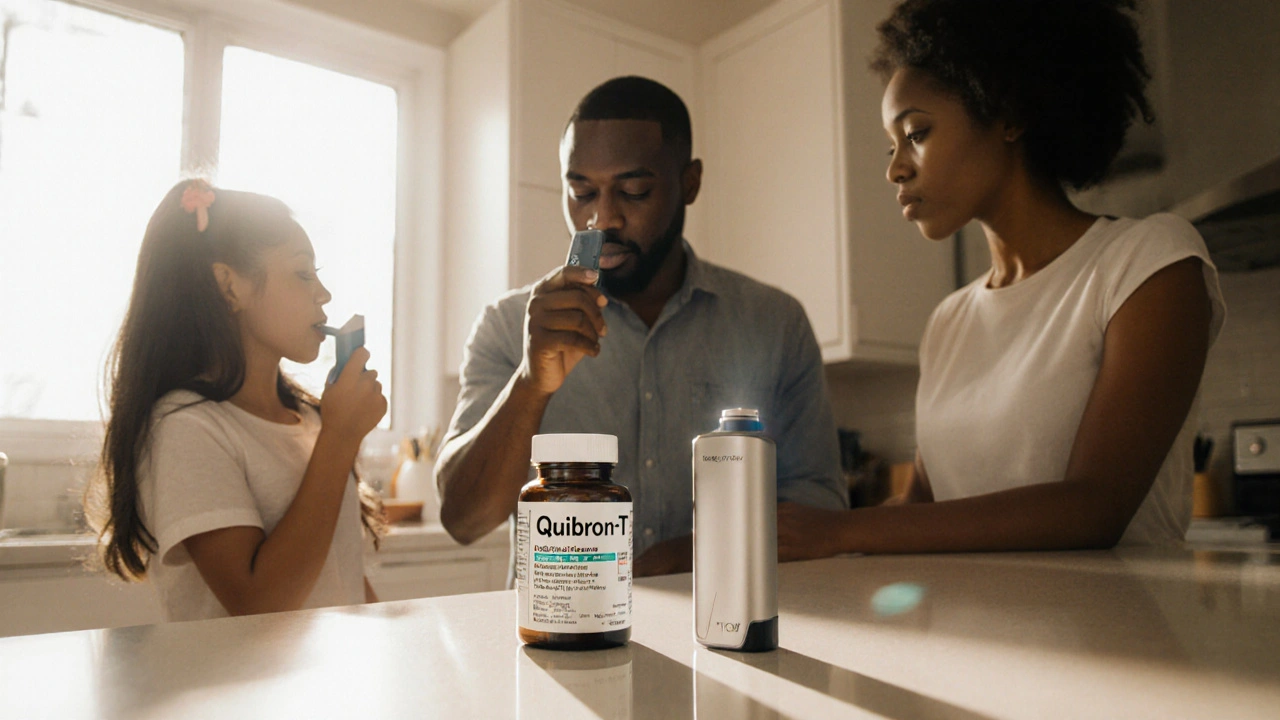
Respiratory Drug Comparison Tool
Select a drug to see its comparison details:
When you’re juggling asthma or COPD, the right inhaler or tablet can feel like a lifeline. Quibron‑T is the brand name for theophylline, a low‑dose methylxanthine that helps relax airway smooth muscle and improve breathing. It’s been on the market for decades, but newer agents promise faster relief, fewer side‑effects, or once‑daily dosing. Below you’ll find a straight‑talk comparison so you can decide whether to stay with Quibron‑T or switch to something that fits your lifestyle better.
Quick Summary
- Quibron‑T works by widening airways and reducing inflammation, but it requires blood‑level monitoring.
- Newer bronchodilators like Albuterol act faster and are inhaled, cutting the need for blood tests.
- Long‑acting agents such as Salmeterol or Tiotropium are ideal for maintenance therapy.
- Anti‑inflammatory pills like Montelukast address leukotriene‑driven symptoms.
- Consider your dosing schedule, side‑effect tolerance, and whether you need a rescue vs. maintenance drug before swapping.
How Quibron‑T (Theophylline) Works
Theophylline belongs to the methyl‑xanthine family, the same class that includes caffeine. It relaxes the smooth muscle in the bronchial tubes by inhibiting phosphodiesterase, which raises cyclic AMP levels and leads to bronchodilation. In addition, it modestly dampens the inflammatory response in the lungs. Because the therapeutic window is narrow-too low, you get no benefit; too high, you risk nausea, tremor, and cardiac arrhythmias-doctors usually order a serum level check after starting or adjusting the dose.
When You Might Look for an Alternative
If you find yourself checking blood work every few weeks, dealing with insomnia, or experiencing heart palpitations, it’s a sign that theophylline isn’t the best fit. Also, its oral dosing schedule (usually 2-3 times a day) can clash with work or sleep patterns. Finally, the drug interacts with many common medications-antibiotics, anti‑epileptics, and even some antidepressants-so poly‑pharmacy patients often get switched to agents with fewer interactions.

Key Alternatives at a Glance
| Drug | Mechanism | Onset | Duration | Typical Use | Common Side‑effects |
|---|---|---|---|---|---|
| Quibron‑T (Theophylline) | Phosphodiesterase inhibition → ↑cAMP | 30-60min | 6-12h | Maintenance for mild‑moderate COPD/ asthma | Nausea, headache, insomnia, tachycardia |
| Albuterol | β₂‑adrenergic agonist | 5-10min | 4-6h | Rapid‑relief (rescue) inhaler | Tremor, jitteriness, throat irritation |
| Salmeterol | Long‑acting β₂‑agonist | 15-30min | 12h | Maintenance therapy (often combined with inhaled steroids) | Chest tightness, rare arrhythmia |
| Montelukast | Leukotriene‑receptor antagonist | 1-3h | 24h | Asthma control, allergic rhinitis | Headache, abdominal pain, mood changes |
| Tiotropium | Long‑acting muscarinic antagonist (LAMA) | 30min | 24h | Maintenance for COPD, some asthma | Dry mouth, urinary retention |
Pros and Cons of Each Option
- Quibron‑T (Theophylline):
- + Oral tablet, useful if inhaler technique is poor.
- + Inexpensive generic version.
- ‑ Requires serum level monitoring.
- ‑ Narrow therapeutic window leads to side‑effects.
- Albuterol (inhaled):
- + Fast relief within minutes.
- + No blood tests needed.
- ‑ Short‑acting; not for daily control.
- ‑ Can cause jittery feeling if overused.
- Salmeterol (LABA):
- + 12‑hour coverage, reduces daily symptom load.
- + Often combined with inhaled corticosteroids for synergy.
- ‑ Not a rescue inhaler; must be paired with quick‑relief med.
- Montelukast (tablet):
- + Works well for aspirin‑induced asthma and allergic rhinitis.
- + Once‑daily dosing.
- ‑ Less effective for acute bronchospasm.
- Tiotropium (inhaled):
- + Once‑daily, improves lung function in COPD.
- + Lower systemic side‑effects than theophylline.
- ‑ Requires proper inhaler technique (soft‑mist device).
How to Choose the Right Drug for You
Start by answering three quick questions:
- Do you need rescue relief or maintenance control?
- Can you reliably use an inhaler, or do you prefer oral tablets?
- How sensitive are you to side‑effects like insomnia or palpitations?
If your answer leans toward “need rescue” and “can handle inhalers,” Albuterol is usually the first pick. For nightly symptoms that need steady coverage, a LABA such as Salmeterol or a LAMA like Tiotropium fits better. When oral medication is a must-perhaps due to limited inhaler coordination-Montelukast or low‑dose theophylline (Quibron‑T) become options, but weigh the monitoring burden.
Another practical tip: many clinicians now favour combination inhalers (e.g., budesonide/formoterol) that give both anti‑inflammatory and bronchodilator action in one device, cutting down on the number of separate meds you need to remember.
Practical Tips & Common Pitfalls
- Never double‑dose theophylline to chase relief; blood levels spike quickly.
- Store inhalers upright and away from extreme temperatures to keep the dose consistent.
- If you start a new antibiotic, ask your doctor to re‑check theophylline levels-some drugs raise blood concentrations.
- Use a spacer with inhaled bronchodilators if you have hand‑tremor; it improves drug delivery.
- Track symptom patterns in a diary; this helps your clinician decide whether a switch is needed.

Frequently Asked Questions
Can I stop Quibron‑T suddenly?
Abruptly stopping theophylline can cause rebound bronchoconstriction. Taper the dose under medical supervision, especially if you’ve been on it for months.
Is a blood test required for every theophylline dose change?
Ideally, yes. Even a small dose adjustment can shift levels out of the safe range, so a follow‑up level check is recommended within a week.
How does albuterol compare to theophylline for exercise‑induced asthma?
Albuterol works within minutes and can be taken 15 minutes before activity, making it far more practical than theophylline, which has a delayed onset.
Are there any natural alternatives to theophylline?
Caffeine has mild bronchodilator effects, but the dose needed for therapeutic benefit is high and can cause jitteriness. It’s not a reliable substitute for prescribed medication.
What should I do if I experience palpitations on Quibron‑T?
Contact your healthcare provider immediately. Palpitations may signal toxic theophylline levels, and a dose reduction or switch to another drug might be necessary.
Bottom line: Quibron‑T still has a niche, especially for patients who can’t handle inhalers or need an inexpensive oral option. But for most people, newer inhaled bronchodilators or leukotriene blockers provide faster relief, fewer blood tests, and a smoother side‑effect profile. Talk to your doctor about your daily routine, symptom pattern, and any other meds you’re on-then pick the drug that fits your life, not the other way around.
15 Comments
Erica Harrington
October 3 2025
Totally agree, the table makes it easy to see who’s got the quick rescue vs. long‑term game. If you’re juggling work and meds, the once‑daily pills like Montelukast or Tiotropium can be a lifesaver. Also, don’t forget to check with your doc about inhaler technique – it makes a huge difference.
Patricia Mombourquette
October 8 2025
theophylline is cheap but its window is narrow watch levels
karl lewis
October 13 2025
When one examines the therapeutic landscape of respiratory pharmacology, it becomes evident that each agent embodies a distinct philosophical approach to disease management. Quibron‑T, as a low‑dose methyl‑xanthine, harkens back to an era where simplicity and affordability were paramount. Yet its narrow therapeutic index demands a vigilant clinician, reminiscent of a watchful guardian. In contrast, albuterol offers rapid relief, embodying the principle of immediacy that modern patients cherish. Salmeterol and tiotropium, with their prolonged actions, reflect a long‑term strategic commitment. Montelukast, targeting leukotriene pathways, illustrates the shift toward molecular specificity. One might argue that the evolution from broad‑spectrum bronchodilators to targeted agents mirrors humanity’s broader journey from crude tools to precision instruments. Nevertheless, the persistence of theophylline in clinical practice suggests that cost and accessibility retain undeniable weight. From a pharmacokinetic perspective, theophylline’s variable metabolism introduces a layer of complexity analogous to the unpredictability of life itself. Clinicians must balance efficacy with the specter of toxicity, a dance as intricate as any philosophical dialectic. The requirement for serum level monitoring can be viewed as an exercise in humility, reminding us that even seasoned practitioners are not infallible. Conversely, the ease of inhaled delivery systems for albuterol or tiotropium speaks to the modern desire for convenience. When counseling patients, the choice of medication should therefore be guided not merely by pharmacology, but by the individual’s daily rhythm, comorbidities, and socioeconomic context. In this sense, the ‘best’ drug is a relational construct rather than an absolute. Thus, whether one opts for Quibron‑T or a newer inhaler, the decision ultimately reflects a partnership between science, patient preference, and the ever‑present quest for optimal breath. :)
Amy Martinez
October 19 2025
Reading your deep dive felt like taking a scenic hike through the pharmacy aisle – you painted each drug with such vivid brushstrokes! I especially resonated with the idea that cost and accessibility still matter; many of us are pinching pennies while trying to catch our breath. Your point about “the dance of efficacy and toxicity” really struck a chord. It’s comforting to know we’re not just picking pills, but weaving a personal narrative of health.
Josh Grabenstein
October 24 2025
some folks think the big pharma push albuterol to keep us buying inhalers while hiding cheaper oral tricks :)
Marilyn Decalo
October 29 2025
Honestly, the hype around “once‑daily” inhalers is overblown – they’re just marketing buzzwords to lock us into pricey devices. Theophylline may feel old school, but it lets you avoid the drama of broken inhaler caps. If you’re tired of the pharmaceutical circus, consider the modest pill.
Mary Louise Leonardo
November 3 2025
yeah the pharma circus is real – they keep swapping meds to keep us confused and buying more.
Alex Bennett
November 9 2025
It’s almost poetic how the industry writes a new chapter every time we finally understand the last one – a never‑ending saga of “new” cures for the same breathlessness. But hey, if a sleek inhaler makes you feel like a sci‑fi hero, who am I to argue?
Mica Massenburg
November 14 2025
just a heads‑up: some of those “once‑daily” patents are tied to hidden fees that show up on your bill later.
Sarah Brown
November 19 2025
Everyone deserves a clear plan that respects their budget and lifestyle. If theophylline works for you, own it and demand proper monitoring – don’t let anyone dismiss your choice. Stay empowered and keep asking questions.
Max Canning
November 24 2025
Exactly! Pump that confidence and keep crushing those inhaler technique drills. You got this!
Nick Rogers
November 30 2025
In reviewing the comparative table, one observes that each medication offers a distinct risk‑benefit profile; consequently, individualized therapy remains paramount.
Tesia Hardy
December 5 2025
Totally agree – picking the right med is like finding the perfect pair of shoes, you need fit, comfort, and style! Keep up the good work.
Matt Quirie
December 10 2025
When clinicians evaluate respiratory agents, they must balance pharmacodynamics, patient adherence, and economic considerations; this comprehensive approach ensures optimal outcomes.






Halle Redick
September 28 2025
Love how this breaks down the options – super helpful!